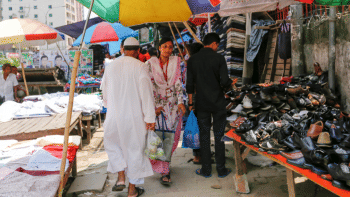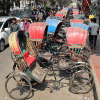Reclaim footpaths from hawkers and extortionists

It's no secret that the teeming thoroughfares of Dhaka also teem with hawkers, a combination that has long been a source of consternation for commuters and pedestrians alike. According to a recent report by this daily, illegal occupation of footpaths by hawkers has turned these public spaces into hotbeds of extortion, with local political leaders, police, and even hawkers' associations collecting fees in the name of "renting" them. Our reporters' account of the money changing hands through this system is quite telling.
For example, on the footpath adjacent to the General Post Office (GPO) in Dhaka, a hawker has to pay Tk 150 daily. It rises to Tk 250 during peak sales periods like Ramadan and pujas. A one-time payment of Tk 1.5 lakh is apparently needed to secure a spot big enough for a stool and a table, while "permanent" ownership would cost between Tk 8-10 lakh, depending on how close it is to the GPO gate. At Motijheel's Shapla Chattar area, hawkers have to pay Tk 100-300 daily, depending on the size of their space, with the rate rising to Tk 400 during festivals. Vendors operating between Elephant Road and New Market areas have to pay Tk 10,000-20,000 twice a year, plus daily fees of Tk 150-300. Similar arrangements likely exist in other major hubs for hawkers including Gulistan, Paltan, Farmgate, Kamalapur Railway Station, Fulbaria, etc.
What this shows us is that there is a very organised, politically-controlled system governing footpath occupation that has proved to be hard to dismantle, despite occasional eviction drives by the city corporations. According to an estimate, there are around 5 lakh hawkers in Dhaka. Their existence has created a unique urban challenge in which we have to balance pedestrian rights with the rights of hawkers to a livelihood. We cannot deny that hawkers play an important role in our economy by providing affordable goods to citizens. So, while it is undeniable that their vulnerability has fuelled a corrupt ecosystem that benefits a select few at the expense of the many—with pedestrians often forced onto busy roads, risking their lives—we must find a balanced approach that benefits both groups.
Firstly, we need to strictly enforce existing regulations against illegal street occupations. City authorities and law enforcement must work in tandem to ensure that footpaths are kept clear for pedestrian use. But evicting hawkers without any rehabilitation plan is neither fair nor sustainable. The authorities, therefore, must pursue a comprehensive course of action. That may include designating special times and places for hawkers, providing them with legitimate spaces to conduct their businesses without disrupting pedestrian flow. Issuing ID cards and collecting nominal fees can also help formalise their operations, ensuring that they contribute to the city's revenue rather than paying extortion money to corrupt elements.


 For all latest news, follow The Daily Star's Google News channel.
For all latest news, follow The Daily Star's Google News channel. 









Comments